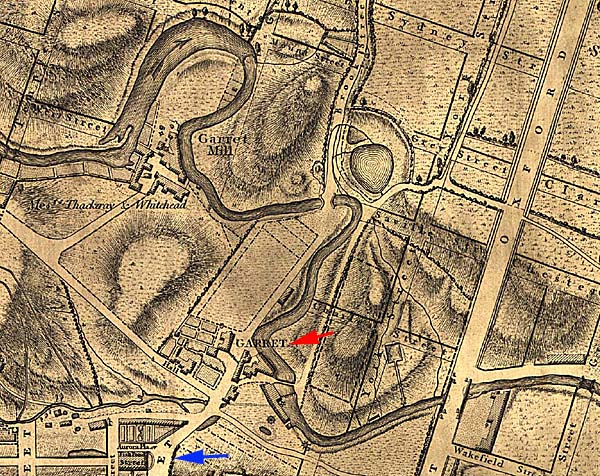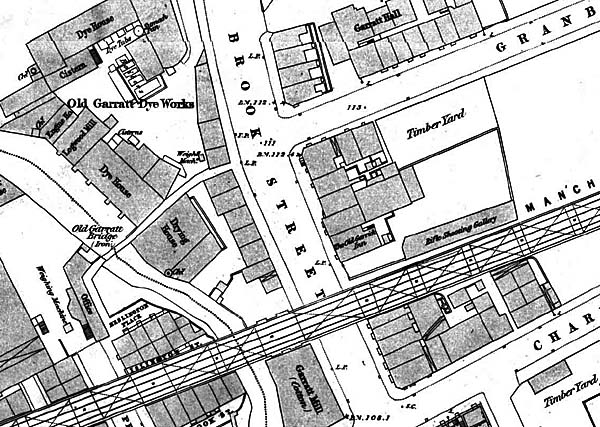The Garratt The Garrat pub occupies the ground
floor of the unremarkable 1970s office block on the
corner of Granby Row and Princess Street. Whilst
the building may lack architectural merit the pub's name
uncovers a long and interesting story about the
location. (In the telling of this story you will
note a number of variations in the way different souces
spelled Garratt.)
The Laurent map of Manchester, dated 1793 shows that on this site stood Garret Hall which British History Online describes as, ".... a black and white timber mansion on a stone base, said to have been similar in style to Hulme Hall, and built on four sides of a quadrangle. The principal front faced south towards the Medlock, which here flowed in a series of curves through a large meadow, and is described as 'extremely picturesque with numerous gables and tall chimneys.' The house, whose position was originally one of defence at the junction of two streams, was surrounded by a park through which Shooter's Brook ran on the north side. It appears to have fallen into decay and to have been let in tenements before the end of the 18th century, but is said to have been standing entire in 1824. One wing was in existence forty years later, and a fragment of the house which could till recently be seen at the back of the north side of Granby Row was not demolished till May 1910. Long before the hall disappeared it was closed in by other buildings, and all traces of the park and original surroundings had long been lost." The red arrow indicated the hall on the map below.  Garret Hall was, "... formerly the seat of a branch of the Trafford family, and was sold in 1595 to Oswald Mosley, a younger brother of Sir Nicholas and Anthony. His son Samuel sold it, but it can be traced in the records down to 1683. Soon afterwards it was acquired by the Minshulls of Chorlton, and again sold in 1775." "Artisan to Graduate - Essays to Commemorate the Foundation in 1824 of Manchester Mechanics’ Institute", published on January 1, 1974, contains another description. " The hall stood at the present Junction of Granby Row and Brook Street. The Elizabethan hall of this name was demolished only some fifty years ago, and is now commemorated only by the “Old Garrat” inn incorporated in a newly built office block on the site. The old hall had very extensive gardens now partly covered by the railway viaduct, the new multi-storey car park and Charles Street. Now covered by Whitworth Street were a number of fish ponds which had probably existed from medieval times for the use of the hall. In the early nineteenth century a small group of cottages stood opposite the ponds, near where the Whitworth Street post office is now. This was named Fishpond Street." ( indicated by the blue arrow above) If you click on THIS LINK you can see an old drawing of Garret Hall from the Manchester Central Library digital collection. Nearby was the Garret Mill owned by Messers Thackeray and Whitehead. This mill was built circa 1760 by a Mr Gartside who apparently attempted, (according to an account in Science & Technology in the Industrial Revolution by Albert Edward Musson & Eric Robinson, published in 1969) "... to work a number of swivel-looms (Dutch, inkle, or ribbon looms) “with a capital water wheel” on the River Medlock. The attempt, however, eventually proved unsuccessful and the mill was converted to cotton spinning. According to Farey it was “the first cotton mill which was established in Manchester. The spinning machinery was on Sir Richard Arkwright’s plan and was worked by water wheels on the river Medlock; but the water power being found insufficient, two engines on Savery’s system were put up by Mr. Joshua Rigley, in 1784, to return the water of the river for the water wheels." As an interesting aside regarding Garret Mill there is a report in this book about Joshua Rigley and his engines. James Watt Junior and his partner Matthew Boulton were contracted to build two engines for a mill near Lancaster for a company in which Joseph Thackeray had an interest. When James Watt discovered that he would need to involve Thackeray’s engineer, Joseph Rigley, he is quoted as saying this, “ I learned at Manchester that Mr. Thackeray employed one Joshua Wrigley as his engineer, whom I object to having anything to do with; first because he is not a good workman if I may judge from a sample of his work I saw there. Secondly because he came here twice with people who wanted engines, and one of the times at least persuaded the person that he could put him up a more advantageous Engine on a principle of his own, ..... thirdly because having erected an Engine for the said Mr Thackeray & Company the smoke of which poisons the whole neighbourhood, he came here pimping to find out how to cure the smoke, which not succeeding, he has built a chimney 100 feet high. To a man of that stamp I will give no instruction.” As you can see from the map below, dated 1844 - 49, the area around Granby Row and what in those days was Brook Street, had many references to Garratt including the Old Garratt Dye Works on the Medlock, the Old Garratt Bridge, Garratt Hall, Garratt Mill on the corner of Charles Street and very oddly a pub where today's Garratt sits called "The Old Garrick Inn"  There is a photograph in the Manchester Central Library digital collection that shows the Old Garrick Inn. If you click on THIS LINK you can see it. This building was demolished circa 1965 and replace in 1973 by the Garratt you see today. Close Window |
|||